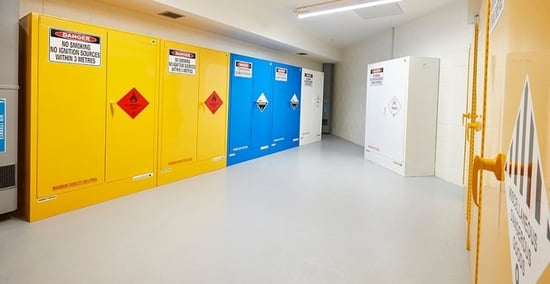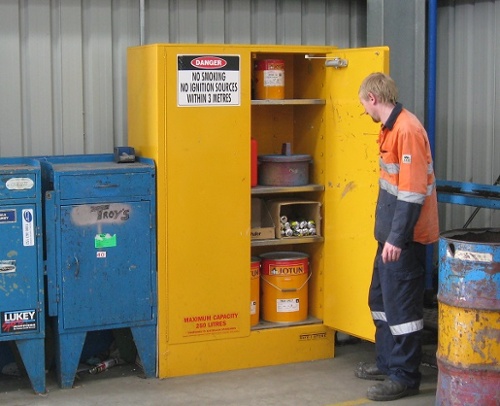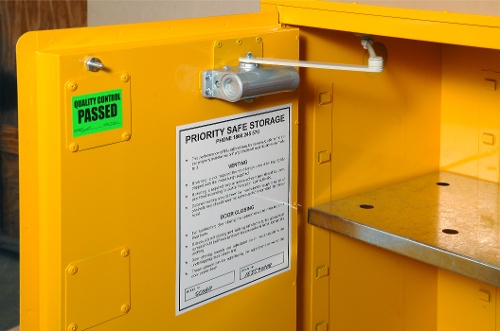Keeping your people and property safe is the ongoing responsibility of every organisation. So, if you’ve chosen to store your flammable liquids in a compliant safety cabinet, it’s a positive first step in achieving compliance. However, to make sure that your safety cabinet stays compliant, you need to develop an inspection checklist for your Class 3 Flammable Liquids cabinets and storage areas.
REMEMBER: You can include information from this post in your inspection reports and compliance audits? Our inspection checklist for flammable liquid storage cabinets will help your business meet the requirements as detailed in WHS Regulations and Australian Standards.
Creating Your Checklist
To start developing your checklist, consider our detailed information below and create an inspection checklist document.
Your inspection checklist should have blank spaces for the following:
- Date and time of inspection
- Name and signature/initials of inspectors/auditors
- Checkbox or compliance indicator next to each item [YES - NO - N/A]
- Details of corrective actions
- Date the corrective action was implemented
- Signature/Initials of operator who implemented corrective action
This will allow you and your team to collate all relevant information into a well organised, up-to-date document that can be shared within your organisation.
Checklist Details
Now, let’s explore some of the inspection criteria that you can apply to your organisation’s flammable liquids cabinets and storage areas.
The main criteria that forms the basis of your checklist should be the ongoing inspection and maintenance of your Class 3 storage cabinet to ensure:
- Compliance of your cabinet and its contents
- Structural integrity to ensure all engineering controls are working as they should
- Effective control and clean-up of flammable liquid leaks and spills by your staff
- Correct housekeeping and maintenance of your cabinet and general storage area
By inspecting and maintaining your flammable liquids cabinet, you’re taking the necessary steps in ensuring your workplace meets its health and safety obligations under the WHS Act. For further information and details about the requirements that relate to flammable liquids storage, please review the Australian Standard AS 1940 which will detail all the necessary precautions when handling and storing Class 3 chemicals.
1. Check the Chemical Containers
Check your flammable liquids chemical containers to see if they comply with the following requirements:
- The chemical containers are suitable for, and compatible with, flammable liquids
- They have labels that are intact, legible and have not been altered or defaced in any way
- Portable chemical containers are properly labelled and bear the appropriate warning signs/hazard statements
- Containers are not leaking and have no visible signs of cracks, puncture marks, breaks, dents, or other damage
- Empty flammable liquids containers have been disposed of properly and safely
2. Check the Flammable Liquids Cabinet
In addition to how you use your cabinet, the nature of your cabinet installation can also affect the safety and compliance of your workplace. When inspecting your flammable liquids storage cabinets, always check for a broad range of issues that could impact compliance.
Inspect your flammable cabinets and check off the following points:
Cabinet Integrity:
- Cabinets are set on solid ground and perfectly level
- Cabinet interior and exterior has no signs of rust, corrosion, dents, or impact damage (all four walls, roof, base and doors)
- Walls are intact and seams have no signs of deterioration or damage
- Cabinet has original shelving and componentry. Shelves are sturdy and fully support the containers stored on them
- Doors close automatically in sequence and are held shut automatically (without jamming)
Stacking & Loading:
- Only Class 3 Flammable Liquids are stored inside the cabinet (eg, no other chemicals or liquids, tools, utensils, rags, materials)
- The cabinet is not loaded past the capacity marked on the front of the cabinet
- Containers and drums are completely enclosed inside the cabinet and not blocking the closing mechanisms
- No more than 2 x drums (over 60 litres) in any stack
- No more than 1 x drum (over 60 litres) resting in the decanting (horizontal) position
Spillage:
- The lower spill compound in the cabinet is not being used as a storage area
- Check for leaks and spills in the spill sump and clean out immediately, disposing of waste safely
Signage:
The flammable cabinet must clearly display the following:
- Class 3 Dangerous Goods label — at least 250mm (nominal length)
- Warning placard with lettering at least 50mm high — ‘NO SMOKING, NO IGNITION SOURCES WITHIN 3m’
- Maximum capacity of the cabinet
- Name and address of manufacturer
- All warning signs and cabinet markings are fully visible when the cabinet doors are closed
Inspect your flammable cabinet to ensure that there’s no signs of deterioration or damage.
Check for Cabinets Over 250 Litres
If your flammable liquids cabinet is over 250 litres, check that the:
- Cabinet is no taller than 2 metres above floor level
- It is not installed against a common wall
- No single flammable cabinet must hold more than 850 L of flammable liquid
Check Aggregate Quantities
Aggregate quantities are at least 10 metres apart and are not exceeded:
- Ground floor — maximum of 850 litres of flammable liquids per 250 square metres.
- Other floors — maximum of 250 litres of flammable liquids per 250 square metres

There are requirements that relate the to aggregate quantities of chemicals that you can store indoors at a workplace.
3. Check the Storage Area
Inspect your organisation’s storage areas to see if the following requirements are being met:
-
Chemical storage area has appropriate warning signs and placards (eg, HAZCHEM)
-
There is no evidence of smoking, hot work, or other restricted activities within 3 metres of the cabinet
-
Ignition sources, incompatible chemicals, gas cylinders, electronic gadgets and heavy machinery are separated from the flammable liquids storage area by a distance of at least 3 to 5 metres
-
First aid equipment, emergency showers, and eyewash equipment can be safely accessed within 10 seconds of the cabinet
-
There is a clear path between the cabinet and the emergency shower and eyewash unit — there are no obstructions or barriers in the way
-
Incompatible medical equipment (eg, defibrillators, O2) is not brought (or used) within 3-5 metres of the cabinet
-
Register of Hazardous Chemicals is in a secure document holder that is attached to the cabinet or within the general storage area. It must contain the current Safety Data Sheets (SDS) for each flammable substance
-
There are no accumulations of waste, dust, tree leaves, pallets, cardboard cartons or other combustible materials near the cabinet
-
Lighting in the storage area is sufficient, fully functional, and there are no discharging sockets or switches
-
There is no maintenance or construction work being conducted near (or above) the flammable liquids cabinet
-
Cabinets are protected from impact from forklifts, vehicles, dropped tools and flying debris
-
External contractors and maintenance workers from other departments have received an appropriate safety induction and are monitored (and properly supervised) while in the flammable liquids store
4. Check Ventilation and Air Quality
Some flammable cabinets may have been fitted with a compliant mechanical ventilation system to assist with safe vapour dispersion. If this applies to your cabinet, make sure you inspect your ventilation system to ensure everything is working to an optimum level.
We also recommend assessing your workplace air quality so you can maintain safety and compliance.
Check your storage with the following criteria in mind:
- There are no indicators that the air surrounding flammable liquids cabinets is contaminated with flammable vapours (eg, strong smell around cabinet, visible indicators)
- There are no indicators that chemical concentration levels are above workplace exposure standards (eg, workers coughing or complaining of stinging eyes)
- Mechanical ventilation system is fully functional
Your Compliance Obligations
Just like all workplace hazard control measures, your safety cabinets need to be regularly inspected, reviewed and maintained so they can continue to meet your legal requirements.

Safety cabinets must be regularly inspected to make sure that they're being used, cleaned and maintained in the correct way.
These requirements can be found in WHS Regulations in Section 37 Maintenance of control measures and Section 38 Review of control measures.
Section 37 of the regulations explains the following in relation to the maintenance of workplace control measures – including flammable liquids cabinets:
37 Maintenance of control measures
A duty holder who implements a control measure to eliminate or minimise risks to health and safety must ensure that the control measure is, and is maintained so that it remains, effective, including by ensuring that the control measure is and remains:
(a) fit for purpose; and
(b) suitable for the nature and duration of the work; and
(c) installed, set up and used correctly.
While Section 38 details the requirements when reviewing control measures in your organisation including:
38 Review of control measures
(1) A duty holder must review and as necessary revise control measures implemented under these Regulations so as to maintain, so far as is reasonably practicable, a work environment that is without risks to health or safety.
As WHS Regulations can be quite broad, your organisation may prefer to refer to the Australian Standards. The standard sets out all relevant guidelines, procedures and specifications that relate to compliant flammable liquids storage. This standard for this type of dangerous goods is AS 1940:2017 – The storage and handling of flammable and combustible liquids.
Some Reasons to Inspect and Maintain your Flammable Cabinets
In addition to your compliance obligations, there are countless reasons that you should regularly inspect and maintain your Class 3 cabinets. These include making sure that:
- The cabinet is installed correctly and located in a safe position
- It’s being used, loaded and stacked in a compliant way
- The packages don’t exceed the maximum capacity limit
- The flammable cabinet is placarded with dangerous goods and hazard signage
- The contents are protected from ignition sources, incompatible substances and materials
- There are no hazards in or around the cabinet
- Leaks, spillage and vapours are closely monitored
- Any cabinet repair or usage issues can be quickly addressed and rectified
REMEMBER: If you’d like some professional guidance, you can also get in touch with one of our Dangerous Goods Specialists. Our team can help your organisation reduce the risks involved with flammable liquids storage needs.
How to Maintain a Compliant Class 3 Cabinet
Following our simple suggestions for developing an inspection checklist for your flammable liquids cabinet is an easy and practical way of reviewing and maintaining your workplace’s hazard controls. As we’ve discussed, it’s so important that you regularly inspect, review and maintain your flammable liquids cabinets — as well as other safety cabinets, outdoor storage and chemical controls. By ensuring that your chemical controls are properly maintained, you’ll be able to keep your workplace safe, effective and compliant.
If you’re interested in learning more, why not check out our FREE eBook? Essential Considerations When Storing Flammable Liquids Indoors offers expert advice on flammable liquids, your compliance obligations and how to store your chemicals safely. Get your copy now to find out more.
Joining the team as a Dangerous Goods Storage Consultant, Melissa Hampton became Storemasta's Marketing Manager in late 2021. With extensive knowledge and experience in chemical compliance, Melissa is responsible for leading the Marketing team and helping shape their marketing strategy. In her spare time, you can find Melissa hiking, swimming and enjoying the great outdoors in beautiful north-west Tasmania.

